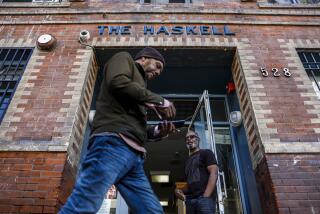Larimer Street: What’s Around the Bend on Last Stretch of Denver’s First Center?
- Share via
DENVER — Most people see the remnants of a Skid Row, a place to drop out with cheap wine, live in a flophouse and chow down on a free bowl of chicken neck soup down at the mission.
Denver historian Thomas J. Noel knows the scene. He recalls sitting one time in the Gold Nugget on Larimer Street. “A business guy came down and took off his shoes and three-piece suit and sold them,” he says. “He’d had enough. Just wanted to take it easy with no responsibilities for a while.”
Today the fate of the last stretch of Denver’s original main street is at a crossroads. One plan would level it to make way for new businesses to serve Denver’s planned major league ballpark, just a stone’s throw away. The other would declare Larimer Street a historical district and restore it to its original grace.
Larimer Street was not always just pawnshops, bars, missions and boarded-up hotels. It was Denver’s birthplace, staked out by Gen. William H. Larimer Jr. just before Christmas, 1858.
Along its 36-block stretch rose City Hall, quarters for the state Legislature, the finest hotels and richest financial institutions in the West.
Calamity Jane shot holes in the ceiling of the luxurious Windsor Hotel’s bar because they wouldn’t serve whiskey to a woman. Presidents and European aristocrats stayed there, too. The Windsor was torn down 23 years ago.
The late Longhorn Building? Bat Masterson slept there.
After the Silver Panic of 1893, big money, the rich and the politicians abandoned Larimer Street, moving south to new quarters.
Larimer Street became a low-rent business district and Denver’s melting pot for immigrants. Over the years it picked up a layer of grime over its peeling paint and moldering bricks.
It became a labor pool where a guy could pick up a day’s wages so he could drink all night and do it all over again tomorrow, according to Noel, author of “Denver’s Larimer Street--Main Street, Skid Row and Urban Renaissance.”
Not much of it is left.
In the last 25 years most of Larimer was torn down to make way for urban renewal and the Auraria higher education campus.
Memories of old Larimer Street are as varied as the people you ask--the pawnbroker, historian, cop on the beat, mission worker, merchant.
In its bawdy heyday, Larimer Street had the salty smell of blue-collar workers and women crowding the sidewalks at night, men shouting to women leaning out of second-story windows.
Capt. Steve Metros, who walked the Larimer Street beat as a rookie in the 1950s, says, “There was a lot of activity then, a lot of small businesses, lots of hotels and taverns. In the pool rooms and a 3.2 (beer) place called Joe’s Buffet, they would have a cutting and shooting once in a while.
“When you consider the amount of people that frequented it then, I wouldn’t say there was a lot of crime.”
Jack L. Dignum, who worked Larimer Street for Volunteers of America for 35 years before retiring in 1988, says, “Working on the street, I never felt any danger. The buildings, even though run-down, were exquisite artworks. Maybe I just closed my eyes to some of the dirt.”
“Back in the ‘50s and ‘60s it was mostly families living in those hotels upstairs over the storefronts,” recalls Eddie Maestas, who has worked on Larimer Street for 48 years and owns Johnnie’s Market.
Maestas remembers families of farm laborers coming to Larimer Street on weekends for the week’s shopping and the neighborhood’s “good variety of ethnic mix”--Polish, Mexican, Italian, Japanese, Jewish.
“When Larimer Street started changing was when urban renewal tore out everything and put in those high-rises,” Maestas says.
“Then the city passed an ordinance for no more cooking in the apartments. The families moved out, of course. They became flophouses for homeless people and pensioners. That eliminated the family orientation.”
A demolition moratorium on an 18-block area, including the last six blocks of Larimer Street’s business district, has been in effect since the Coors Field site was identified in September, 1991. It expires next month, according to Ellen Ittelson of the city planning office.
“We’re trying to save what is there,” she says. “It’s a very important part of Denver’s history.”
The planning office’s findings will be presented to the landmark commission, which, in turn, will make a recommendation to the Denver City Council.
The council will make the final decision.
If approved, demolition of buildings would be prohibited, there would be a design review of any remodeling within the district, and state income tax credits equaling 20% of rehabilitation costs would be extended for five years.
But people like Fred Pasternack, a second-generation pawnbroker, don’t have much truck with the preservationists.
“They’re causing a lot of grief and delaying growth and progress,” Pasternack says. “These buildings are old and decrepit--not my building, of course.”
Pasternack envisions the area between 20th and 24th streets on Larimer as a venue for new sports bars, fast-food restaurants and parking lots to serve the ballpark.
Maestas, a vice president in the North Larimer Merchants Assn., has a different vision. He sees the area restored as a historical part of Denver and an international marketplace.
“It’s already in place,” he says.
More to Read
Sign up for Essential California
The most important California stories and recommendations in your inbox every morning.
You may occasionally receive promotional content from the Los Angeles Times.













